

Economists predict NZ missed recession 2.0 14/6/21. Economists say it’s likely that New Zealand dodged a technical recession in the early part of this year.

A recession is most often categorised as two consecutive quarters of negative GDP growth. If data due on Thursday shows there was a fall in the March quarter, after a 1 per cent drop in December, that would put the country in that category. Earlier in the year, it was expected that New Zealand would go through a “double-dip” recession, before getting back on track to recovery after the Covid-19 lockdown. After New Zealand returned to level 1 last June, GDP jumped by a historic 14 per cent. New Zealand Avoids Recession as Economic Growth Surges 17/6/21.
Bill Rosenberg on NZs productivity paradox v3. New Zealand - Inflation rate 2026. Basic Account Get to know the platform You only have access to basic statistics.
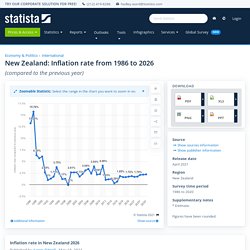
Single Account The ideal entry-level account for individual users Instant access to 1m statisticsDownload in XLS, PDF & PNG formatDetailed references. New Zealand OECD Stats. Unemployment rate falls to lowest in nearly a year. The unemployment rate has fallen to its lowest level in nearly a year.
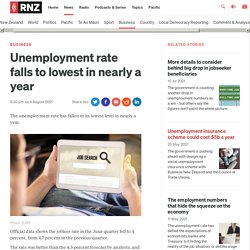
Photo: 123RF Official data shows the jobless rate in the June quarter fell to 4 percent, from 4.7 percent in the previous quarter. The rate was better than the 4.5 percent forecast by analysts, and is below the level before the pandemic. The number of unemployed people fell by 12.4 percent - the largest quarterly percentage fall in unemployment since Stats NZ's Household Labour Force Survey began in 1986. Unemployment rate. New Zealand Employment Rate. Employment Rate in New Zealand increased to 67.10 percent in the first quarter of 2021 from 66.80 percent in the fourth quarter of 2020. source: Statistics New Zealand Employment Rate in New Zealand averaged 62.90 percent from 1986 until 2021, reaching an all time high of 68.20 percent in the third quarter of 2018 and a record low of 56.40 percent in the fourth quarter of 1991.

This page provides - New Zealand Employment Rate- actual values, historical data, forecast, chart, statistics, economic calendar and news. New Zealand Employment Rate - values, historical data and charts - was last updated on August of 2021. Employment Rate in New Zealand is expected to be 67.40 percent by the end of this quarter, according to Trading Economics global macro models and analysts expectations. Gross domestic product (GDP)
NZ's poor productivity linked to fear of technology. Improving productivity in New Zealand’s economy. New Zealand firms' productivity lower than comparable economies - report. The productivity of leading companies in New Zealand is on average less than half of that found in the top companies in other small advanced economies.
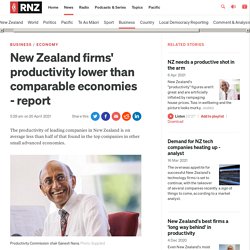
Productivity Commission chair Ganesh Nana. Photo: Supplied The Productivity Commission has released its findings into what are known as frontier firms, the top 10 percent. How do we solve New Zealand's poor productivity? Productivity improvements are hard. But research shows than the biggest gains can be had by simply “catching up” with existing best practices. A missing collective aspiration to be better, to trying harder, is holding us back.
While many advanced countries have suffered from falling productivity since the Global Financial Crisis, New Zealand’s productivity performance has been lacklustre since the mid-1990s.
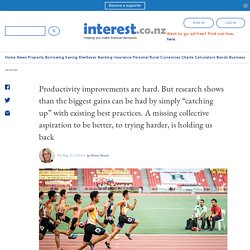
Our productivity growth since 1996 has been a paltry 1.4 percent and our output per hour worked is 40 percent below the top half of OECD countries. This is concerning since a country's ability to improve its standard of living in the long term depends almost entirely on its ability to raise its output per worker. In fact it has been shown that at least two thirds of global GDP growth since the beginning of the first industrial revolution resulted from increased labour productivity. Source: OECD. Five numbers that tell the story of NZ’s productivity failure. New Zealand’s productivity has long lagged behind other developed countries.

A new report from the Productivity Commission offers clues on how we compare and the ways we might improve. New Zealand’s productivity record has been the subject of much scrutiny and puzzlement in recent decades. Despite our lack of corruption and ease of doing business – consistently ranked among the best in the world – productivity has tended to lag behind other OECD countries. The Detail: New Zealand is not as productive as we should be, what does that mean? The Detail is a daily news podcast produced for RNZ by Newsroom and is published on Stuff with permission.

Click on this link to subscribe to the podcast. It's the elephant in the room – if elephants were a mysterious, multifaceted combination of complicated economic and social metrics few people could elegantly describe. Despite New Zealand's relatively good GDP growth over time, our productivity growth has lagged: since 1996, when labour productivity first began to be measured, our productivity growth has averaged about 1.4 per cent. Between 2008 and 2018, that drops to just one per cent. READ MORE: * Hey Productivity Commission, leave 'social justice' alone * No immediate panacea for housing crisis post-Covid, business leaders told * Ganesh Nana appointed to chair Productivity Commission * Productivity Commission asked to review NZ business' key issue - productivity.
Productivity by the Numbers / 2013 report. Working longer hours but producing less: NZ's poor productivity. New Zealand’s poor productivity is highlighted in a new report showing people are working longer hours and producing less compared with other OECD countries.
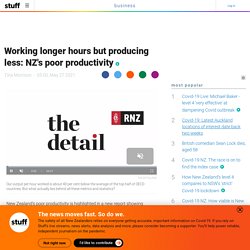
The Productivity Commission’s Productivity by the numbers report released on Thursday shows New Zealanders worked 34.2 hours per week, higher than the 31.9 hours per week worked in other OECD countries, and produced $68 of output per hour, less than the $85 per hour in other OECD countries. The figures cover the year to March 2020. Brief history of NZ's recessions : Here's what past recessions can teach us. ANALYSIS: Tough times are here.

New Zealanders are facing up to an economy in recession which shrank by 12.2 per cent in the three months to the end of June. Tens of thousands of households and businesses are struggling to pay their mortgages, overdrafts and bills, but history shows coping with the rigours of recessions, depressions and economic shocks is something every New Zealander should bank on doing fairly often in their lives. New Zealand has around 34,000-odd people aged over 90, and the parade of recessions, depressions and shocks they’ve experienced makes for sobering reading.
IMF Report : Turning New Zealand’s Recovery into Sustained Growth. Productivity Commission. Productivity statistics: 1978–2019. In the year ended March 2019: labour productivity rose 0.5 percentmultifactor productivity rose 0.3 percentcapital productivity rose 0.1 percent. Key aggregates for the measured sector.